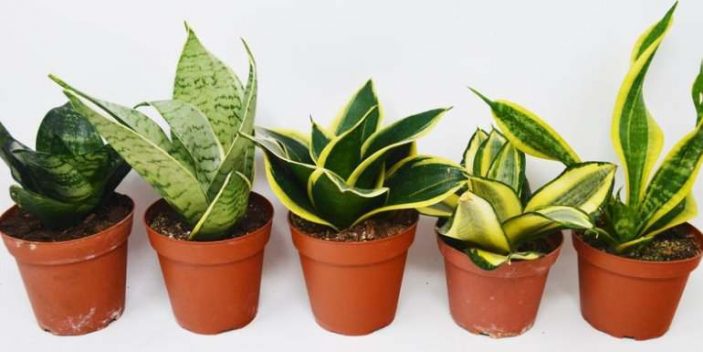Belonging to family Asparagaceae, the Sansevieria trifasciata, is an indoor and outdoor ornamental plant native to West Africa, from Congo west to Nigeria, Southern Asia, and Madagascar.
It is known by other names including snake plant, mother-in-law’s tongue, Saint George’s sword, devil’s tongue, jinn’s tongue, or viper’s bowstring hemp, good luck plant, Magic sword, golden bird’s nest, et cetera.
Some of its common varieties include black gold, futura robusta, futura superba, cylindrica, golden hahnii, blackjack, black robusta while the compacta, hahnii, Laurentii, and the Silbersee are some its popular cultivars.
Identification
Sansevieria trifasciata is an evergreen perennial plant with “stiff, very thick leaves, often mottled with white, and clustered flowers on slender stalks,” notes Plantcaretoday.com and greenish-white flowers that grow in clusters on stalks that are slender. It can grow between 6-42 inches tall.

According to Joy US Garden, expect, cultivars that are “tall or short, with round, flat or concave leaves, and variegated with dark green, silver, light green, yellow, chartreuse or white.”
Why is ornamental versatile?
Firstly, it can tolerate indoor environments that are brightly or poorly lit. This makes it a good choice even if your house or apartment is not well lit.
Secondly, as Wikipedia states “the NASA Clean Air Study found S. trifasciatahas potential indoor air filtration qualities, removing 4 of the 5 main toxins involved in the effects of sick building syndrome.”
Finally, it can thrive in a warmer and cooler climate, i.e., in warmer climates, it is used in the garden or for landscaping as well as indoors. However, in cooler climates, it serves as a houseplant.
Is snake plant poisonous or safe to cats?
If you have it, you deserve to know that snake plants poisonous to cats and dogs because it has saponins as ASPCA. notes
It joins ranks with other toxic ornamental plants such as aloe, sago palm, Dracaena frangrans, many varieties of lilies, daffodils, azalea, chrysanthemum, hydrangea, tulips, and so on.
Toxicity occurs if your kitten, puppy, cat, or dog ingests any part of this plant. The saponins act as natural insecticides and fungicides and make this plant bitter and toxic to these pets. Most kitties will not bite it again once they realize it is bitter.
Its toxicity is mild to moderate. Commonly noted symptoms of poisoning include nausea, diarrhea, and vomiting. Other signs include drooling, reduced appetite, lethargy, depression, abdominal discomfort as well as swollen tongue, mouth or lips.
In case of any of these symptoms, take your kitty to your vet for proper diagnosis and treatment. Treatments will involve mainly supportive care to ensure your feline pal recovers fast and removing any remaining Sansevieria trifasciata in your cat’s mouth and teeth.
IV fluids may be recommended in case of vomiting and diarrhea while antihistamine will help reduce swelling in case of an allergic reaction. Your vet may also prescribe Kapectolin to protect your feline’s stomach lining or Sucralfate to reduce gastrointestinal irritation.
Recovery is expected within a day or two. Prognosis is good as Sansevieria trifasciata is not likely to kill your pet since its toxicity is mild to moderate.
Conclusion
Since the snake plant is not cat-friendly, avoid having them or any others that poisonous to cats. Instead go for kitty-safe ones such as palms, staghorn fern, Christmas cactus, African violet, baby’s tears, among many others.
